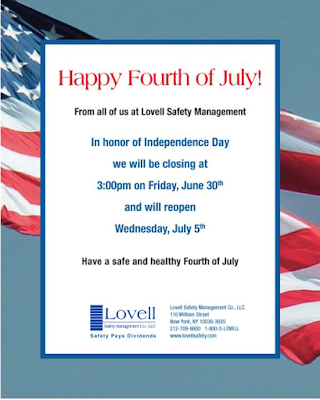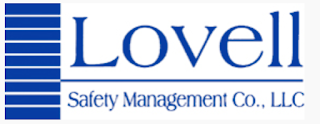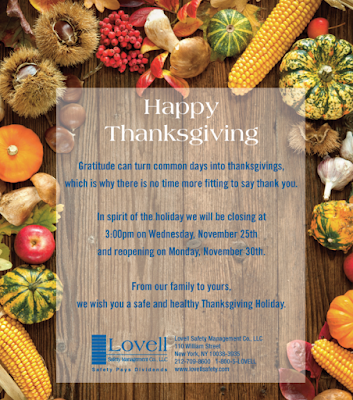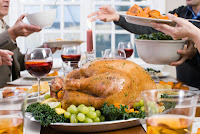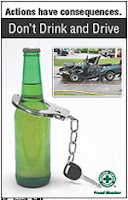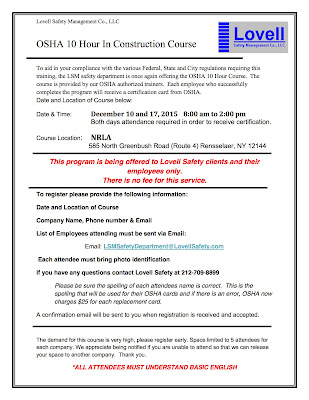OSHA’s New Rules on Retaliation Incentive Programs, Post-Incident Drug Testing and Disciplinary Programs
need to determine whether or not their safety incentive programs, as well as their
post-accident drug and alcohol testing programs and disciplinary program,
comply with OSHA’s new requirements.
OSHA published a final rule that updated requirements for reporting
work-related injuries and illnesses, which also included a new provision that specifically
addressed retaliation for reporting incidents. Subsequently, OSHA released a
memo providing guidance on how to comply with the various requirements found in
the final rule. The memo addresses an employer’s obligation to have “reasonable
procedures” in place for employees to report injuries and illnesses without the
fear of retaliation.
anti-retaliation section, which is one of the most important for employers to
understand, describes what OSHA will consider a violation when looking at the
overall reporting program—especially in determining if there is a potential for
retaliation against employees who report incidents (for example, withholding a
benefit—such as a cash prize drawing or other substantial award—simply because
of a reported injury or illness). The
rule doesn’t prohibit incentive programs.
incentive programs that deter or discourage any employee from reporting an
injury or illness.
Safety Incentive Programs
promote worker participation in safety-related activities. Not only will these
types of incentive programs comply with OSHA, but they will also be more
effective in encouraging safe behavior, thereby reducing the number of injuries.
Some examples of behaviors that can be rewarded with an effective incentive
programs include:
- Participation
in safety program activities and evaluations; - Completion
of safety and health training; - Reporting
and responding to hazards and close calls/near misses; - Safety
walk-throughs and identification of potential safety hazards; - Compliance
with planned preventive maintenance schedules; - Following workplace
safety rules.
safety incentive program is to reward safe behavior rather than the lack of an
injury. A positive way of accomplishing this is by setting up a program that will
provide a cash prize for each work group that goes an entire month with all
members of the work group complying with specific safety rules, such as wearing
required fall protection. Supervisors of each work group should be rewarded as
well. Rewards should be at least every 6 weeks, and can build up to a year-long
grand prize.
such an incentive program, what happens if an employee sustains a lost-time
injury by falling off a platform while not wearing the required fall protection
and he reports the injury to the employer? The employer can then cancel the cash prize
drawing for that specific work group that month because the employee failed to
wear the required fall protection, NOT because he was injured. However, there
must be an active incentive program in place and the employer must be actively
monitoring for compliance. Employees cannot receive the reward when they do not
use the fall protection, regardless of whether or not an injury occurred.
testing required by the Department of Transportation rules or any other federal
or state law. It only
prohibits employers from using drug testing, or the threat of drug testing, to
retaliate against an employee for reporting an injury or illness.
Employers can
conduct post-incident drug testing if there is a “reasonable possibility” that employee drug use could have
contributed to the reported injury or illness. However, if employee drug use
could not have contributed to the injury or illness, post-incident drug testing
would likely only discourage reporting without contributing to the employer’s
understanding of why the injury occurred. Drug testing under these conditions
could be considered retaliation.
For example,
if an employee reports a repetitive strain injury and the employer requires
post-incident drug testing, then that testing would be prohibited because it is
unlikely that a repetitive strain injury would be related to drug use by the
employee. In a different situation, it would be reasonable for an employer to
require post-incident drug testing for a worker who reported an injury while
operating a forklift if the employee’s conduct contributed to the injury.
Employers do not need to specifically suspect drug use before post-incident
testing, but there should be a “reasonable”
possibility that drug use by the reporting employee could have contributed to
the reported injury or illness. Prior to any drug/alcohol testing a company
policy must be in place and administered uniformly.
action, or the threat of disciplinary action, to retaliate against an employee
for reporting an injury or illness.
employees simply because they report work-related injuries or illnesses without
regard to the circumstances of the injuries or illnesses, such as automatically
suspending workers who report an injury. The rule also does not allow disciplining
an employee who reports a work-related injury or illness by stating that
the employee violated a work rule if the real reason for the discipline was the
reporting of an injury. For example, if an employer disciplines an employee who
reported a work-related injury for violating a work rule, but fails to enforce
the work rule against other employees who violate the same rule but do not
report an injury. It is the same as described in the safety incentive program
criteria.
retaliation is seen is when an employer disciplines an employee who reported an
injury or illness for violating a vague rule such as “work carefully”
or “paying attention.” In this example, the reported injury or illness
is often the only basis for disciplining the employee. A rule of thumb to
follow is if the employee had not reported the injury or illness, would the
employer have still disciplined the employee?
If not, then the employer cannot discipline them if they report an
injury.
Effective and legitimate
workplace safety programs should treat all workers who violate safety rules in
an equivalent manner, regardless of whether or not the violation resulted in
the worker reporting an injury or illness. On the other hand, employees who
follow the rules should be rewarded fairly and equally as well.
Dividend News from Lovell Safety Management
New York, NY… Lovell Safety Management Co., LLC, announced the 2015 – 2016 dividend earnings of three of its Safety Groups:
Safety Group #275 paid a 10 percent dividend. Qualifying members received an advance discount of 20 percent.
Safety Group #469 paid a 25 percent dividend. Qualifying members received an advance discount of 25 percent.
Safety Group #514 paid a 30 percent dividend. Qualifying members received an advance discount of 25 percent.
Lovell Safety Groups are fully insured, non-profit entities that return any underwriting profit to group members. Any extra premium dollars collected-not used to pay losses or expenses-can be returned to members in the form of a dividend. Lovell Safety Groups provide businesses with the benefits of a guaranteed cost premium with additional savings earned through dividends.
Winter Storms and Employee Safety
faced with the threat of severe winter storms hitting the New York area. We at
Lovell Safety Management Co., LLC saw an increase in the number of employee
injuries due to last year’s severe winter weather. Now is the perfect time to
spend a few minutes with your employees discussing their safety during these
storms. Winter storms create a variety of hazards and can have lingering impacts
on everyday tasks and work activities.
prepare for a winter storm and avoid hazards when they occur will help keep you
safe during the winter season.
and Hypothermia
reaction to cold exposure that causes freezing in the deep layers of skin and
tissue. Frostbite can cause permanent damage. It is recognizable by a loss of
feeling and a waxy-white or pale appearance in fingers, toes, nose, or ear
lobes.
the body temperature drops to less than 95°F. Symptoms of hypothermia include
uncontrollable shivering, slow speech, memory lapses, frequent stumbling,
drowsiness, and exhaustion.
hypothermia, take frequent breaks and drink plenty of fluids (avoiding ones
with caffeine or alcohol).
layers of loose fitting clothing. Layering provides better insulation.
An inner layer of wool, silk or synthetic material to keep
moisture away from the body.
A middle layer of wool or synthetic to provide insulation even when
wet.
An outer wind and rain protection layer that allows some
ventilation to prevent overheating.
cover your face and mouth. A hat that covers your ears will help keep your
whole body warmer. Also, insulated and water proof boots gloves.
walking surfaces of snow and ice and use salt or its equivalent. In addition,
the following precautions will help reduce the likelihood of any injuries:
- A pair of well-insulated boots with good rubber treads is a must for walking during or after a winter storm.
- Take short steps and walk at a slower pace so you can react quickly to a change in traction.
- Be on the lookout for vehicles that may have lost traction and are slipping toward you. Be aware that approaching vehicles may not be able to stop at crosswalks or traffic signals.
- At night, wear bright clothing or reflective gear, as dark clothing will make it difficult for motorists to see you.
Snow
activity and can create the potential for exhaustion, dehydration, back
injuries, or heart attacks. Wearing the proper footwear, adequate layers of
clothing, and sunglasses (during the day) is a must.
scoop small amounts of snow at a time, push the snow instead of lifting where
possible, and use the proper form if lifting is necessary. Use power blowers
whenever possible.
in a vehicle during a winter storm
may become disoriented and lost in blowing and drifting snow. Display a trouble
sign by hanging a brightly colored cloth on the radio antenna and raising the hood.
engine for about 10 minutes each hour and run the heat to keep warm. Beware of
carbon monoxide poisoning. Keep the exhaust pipe clear of snow, and open a downwind
window slightly for ventilation.
frostbite and hypothermia. Do minor exercises to keep up circulation. Use newspapers,
maps, and even the removable car mats for added insulation until help arrives.
mobile equipment lead to many work zone fatalities or injuries annually.
Drivers may skid, or lose control of their vehicles more easily when driving on
snow and/or ice covered roads. It is therefore, important to properly set up
work zones with the traffic controls identified by signs, cones, barrels, and
barriers, to protect workers. Workers exposed to vehicular traffic should wear
the appropriate high visibility vest at all times, so that they can be visible
to motorists
of Downed Trees
critical job during a winter storm. When winter storms occur, downed trees can
block public roads and damage power lines. Emergency crews are often sent out
to clear downed trees during a winter storm. Potential hazards include:
- Electrocution
by contacting downed energized lines or contacting broken tree limbs in contact
with fallen lines. - Falls
from trees. - Being
struck or crushed by falling tree limbs or ice. - Being
injured by equipment such as chain saws and chippers.
equipment should be worn by workers using chainsaws and chippers. Only
appropriate power equipment that is built to be used outdoors and in wet conditions
should be used. It is important that all equipment is well-maintained and functioning
correctly in order for use. In addition, all equipment should have proper
guarding, working controls, and other safety features as installed by the
manufacturer.
Working at Heights
fatalities in the past 10 years due to employees clearing snow from roofs. Following
a winter storm, workers should employ standard protections when working at
heights and should also be aware of the potential for unexpected hazards due to
the weather. Employers should provide and ensure the use of fall protection and
provide and maintain ladders. In addition, workers should use caution around
surfaces that have been weighed down by snow, as they may collapse.
preventing employee injuries. Owners are responsible for providing a safe and
healthy workplace, the needed tools, protective equipment and training. Supervisors
must be empowered to discipline employees for at risk behavior and employees
must do their job safely.
site injuries. Safety, especially during winter storms, must be an integral
part of the way we work. That is the only way to create a truly safe and
healthy workplace.
winter storm safety:
Holiday Safety Tips Curtesy of The National Safety Counsel
|

